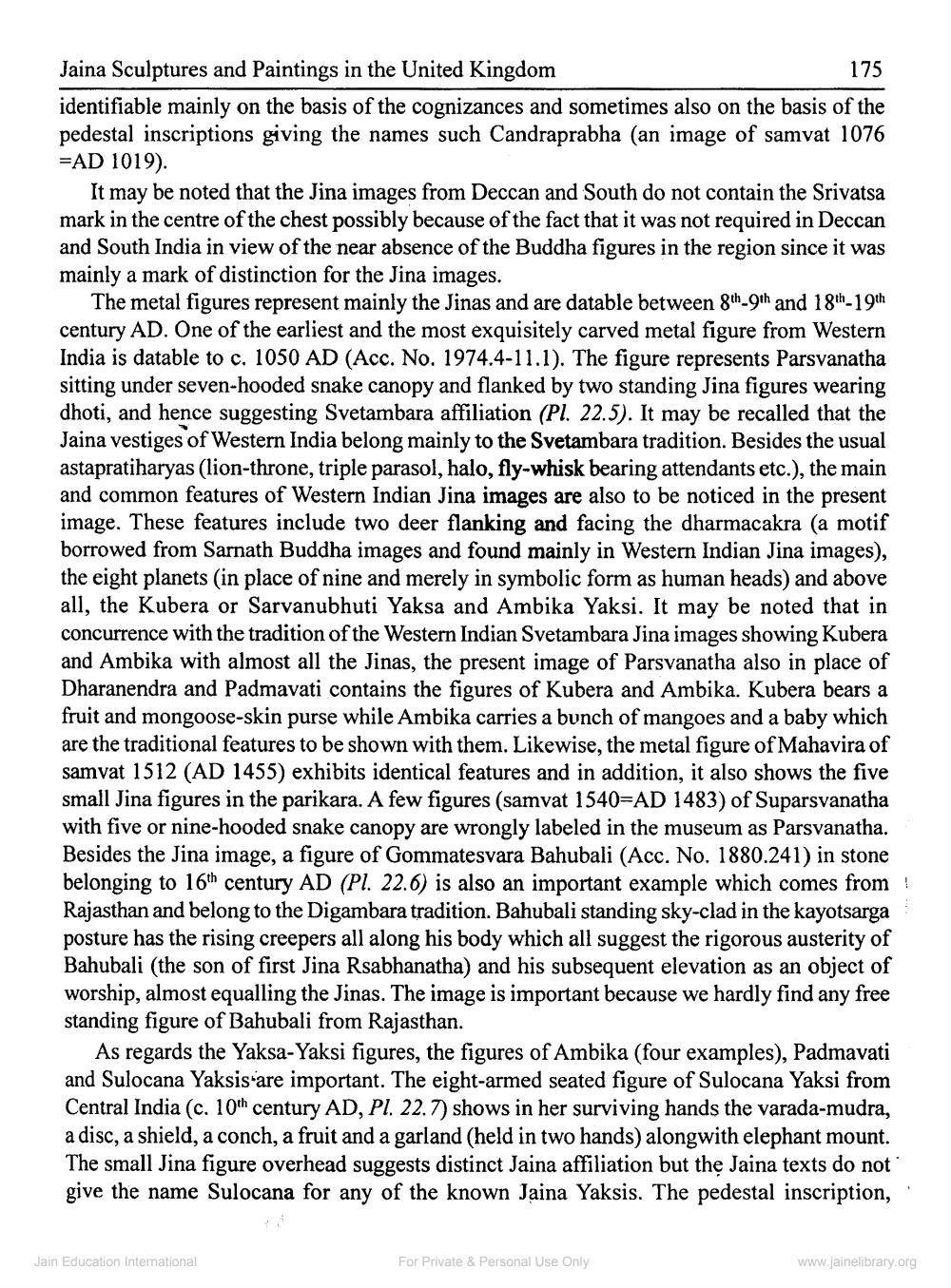________________
Jaina Sculptures and Paintings in the United Kingdom
175 identifiable mainly on the basis of the cognizances and sometimes also on the basis of the pedestal inscriptions giving the names such Candraprabha (an image of samvat 1076 =AD 1019).
It may be noted that the Jina images from Deccan and South do not contain the Srivatsa mark in the centre of the chest possibly because of the fact that it was not required in Deccan and South India in view of the near absence of the Buddha figures in the region since it was mainly a mark of distinction for the Jina images.
The metal figures represent mainly the Jinas and are datable between 8th_9th and 18th-19th century AD. One of the earliest and the most exquisitely carved metal figure from Western India is datable to c. 1050 AD (Acc. No. 1974.4-11.1). The figure represents Parsvanatha sitting under seven-hooded snake canopy and flanked by two standing Jina figures wearing dhoti, and hence suggesting Svetambara affiliation (Pl. 22.5). It may be recalled that the Jaina vestiges of Western India belong mainly to the Svetambara tradition. Besides the usual astapratiharyas (lion-throne, triple parasol, halo, fly-whisk bearing attendants etc.), the main and common features of Western Indian Jina images are also to be noticed in the present image. These features include two deer flanking and facing the dharmacakra (a motif borrowed from Sarnath Buddha images and found mainly in Western Indian Jina images), the eight planets (in place of nine and merely in symbolic form as human heads) and above all, the Kubera or Sarvanubhuti Yaksa and Ambika Yaksi. It may be noted that in concurrence with the tradition of the Western Indian Svetambara Jina images showing Kubera and Ambika with almost all the Jinas, the present image of Parsvanatha also in place of Dharanendra and Padmavati contains the figures of Kubera and Ambika. Kubera bears a fruit and mongoose-skin purse while Ambika carries a bunch of mangoes and a baby which are the traditional features to be shown with them. Likewise, the metal figure of Mahavira of samvat 1512 (AD 1455) exhibits identical features and in addition, it also shows the five small Jina figures in the parikara. A few figures (samvat 1540=AD 1483) of Suparsvanatha with five or nine-hooded snake canopy are wrongly labeled in the museum as Parsvanatha. Besides the Jina image, a figure of Gommatesvara Bahubali (Acc. No. 1880.241) in stone belonging to 16th century AD (Pl. 22.6) is also an important example which comes from Rajasthan and belong to the Digambara tradition. Bahubali standing sky-clad in the kayotsarga posture has the rising creepers all along his body which all suggest the rigorous austerity of Bahubali (the son of first Jina Rsabhanatha) and his subsequent elevation as an object of worship, almost equalling the Jinas. The image is important because we hardly find any free standing figure of Bahubali from Rajasthan.
As regards the Yaksa-Yaksi figures, the figures of Ambika (four examples), Padmavati and Sulocana Yaksis are important. The eight-armed seated figure of Sulocana Yaksi from Central India (c. 10th century AD, Pl. 22.7) shows in her surviving hands the varada-mudra, a disc, a shield, a conch, a fruit and a garland (held in two hands) alongwith elephant mount. The small Jina figure overhead suggests distinct Jaina affiliation but the Jaina texts do not give the name Sulocana for any of the known Jaina Yaksis. The pedestal inscription,
!
Jain Education International
For Private & Personal Use Only
www.jainelibrary.org




